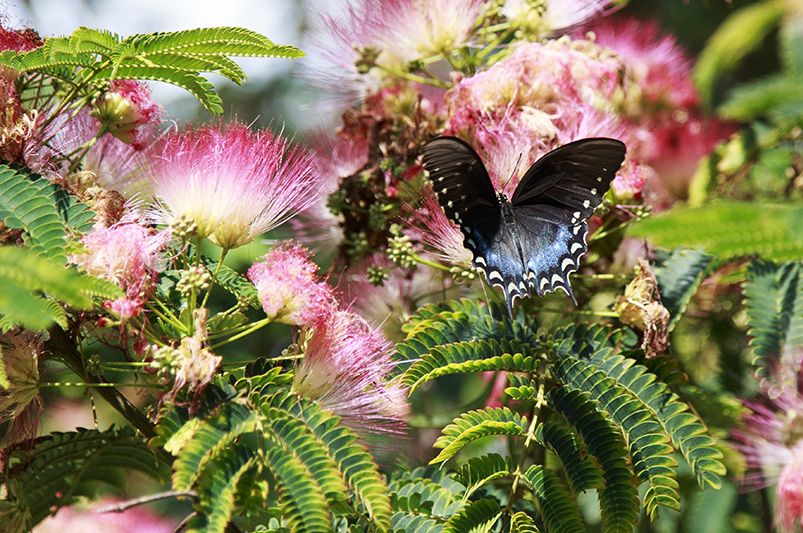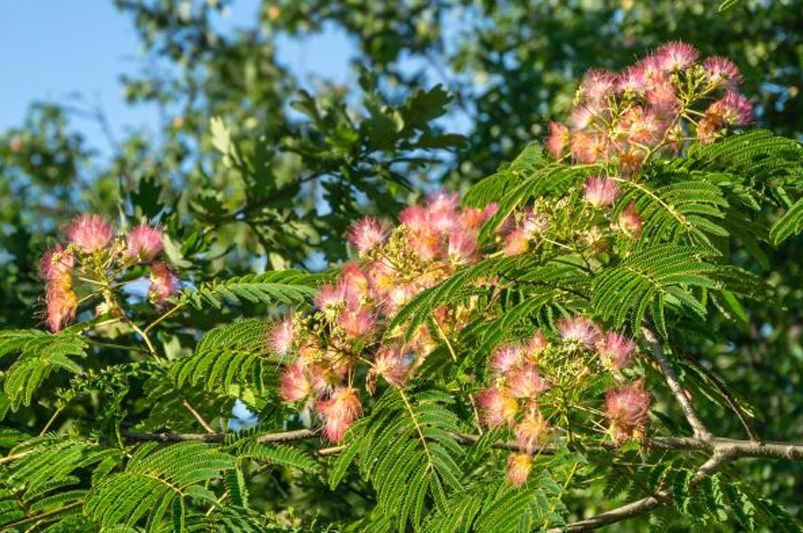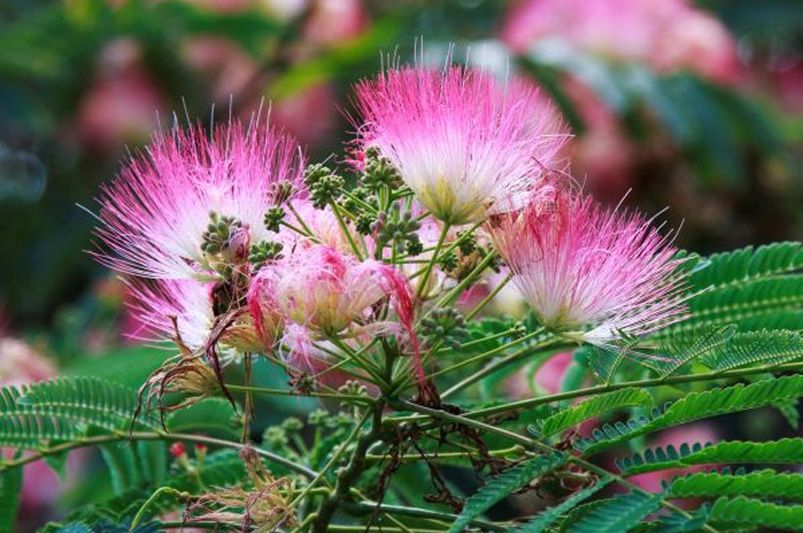
How to Grow a Mimosa Tree: A Step-by-Step Guide
Published: 25/03/2024 | Updated: 25/03/2024
Looking to give your garden a bit of an exotic touch? The enchanting Mimosa tree might just be what you’re looking for! This tree’s vibrant pink blossoms and frond-like leaves are sure to catch anyone's attention who passes by. But how do you grow this magnificent creature you ask? Look no further! In this article, we will guide you through it step by step.


Starting from picking the best spot fast-growing tree, to making it bloom, many secrets of young Mimosa trees can be unlocked in this fascinating journey of botany. So get those gardening tools ready because it’s about to bring your garden alive in ways you never even thought possible!
What are Mimosa Trees?
If you’re new at gardening, you might be asking yourself ‘what are Mimosa Trees?’ These stunning ornamental hardy trees also known as Albizia julibrissin originated from Asia and Iran. They display fluffy pom-pom-looking flowers with soft pink-magenta petals and have graceful greenery.
Mimosa trees’ history is not as ordinary as their appearance may suggest. Introduced into Europe during the eighteenth century, they quickly became very popular among people living in homes across the continent while searching for perfect plants for their gardens. By the middle of east 19th century, they made their way to America where these unique specimens of native vegetation were beloved and cherished for their beauty thus being planted all over the place.
Mimosa trees are deciduous and can grow up to 40 feet in height with a spread of up to 35 feet. Their wide-spreading canopy which resembles an umbrella shades under gardened areas giving an appearance of a tropical zone around them. Fine-looking delicate fern-like leaves add elegance to its look.
Once it gets into full bloom, the scent from mimosa trees creates a sweet aroma that attracts bees, butterflies, and other pollinators hence an excellent choice for any wildlife-friendly garden.
For landscapers or beginners who love plants, Mimosa Trees give your outdoor area an elegant and whimsical look. They are eye-catching and fragrant, making them a perfect addition to any garden or landscape.

What Environment is Best for Mimosa Trees?
So you want to make your Mimosa tree thrive? Then you must provide it with the right environment to do so. Also known as Albizia julibrissin, Mimosa trees come from subtropical and tropical regions but they can still do well even in places with temperate climates.
Just like sun worshippers crave the sun, these trees also desire warmth and sunlight. Therefore, choose an area that receives plenty of both. Ideally, your Mimosa tree grows and wants at least six hours of full sun daily so that it can produce its gorgeous pink flowers by harnessing energy from the sunlight.
However, if you stay in areas with cold temperatures do not worry; this species of invasive tree is highly adaptable and can be grown anywhere provided they are taken care of properly. So let us find that corner in your garden that has a partial shade that will make your Mimosa tree feel like it is on holiday all year!
How to Grow a Mimosa Tree
The idea of growing a Mimosa tree might sound hard but trust us, with our guidance it’ll seem like a piece of cake. Here’s how to bring new growth of this beautiful spectacle of young plants into your garden in just a few steps:
-
Picking The Right Spot: Bright and sunny are the two things you should have in mind when picking a spot for your Mimosa. It needs at least six hours of sunlight daily.
-
Prepare The Soil Next: Having well-draining soil is crucial for this tree’s growth. To do that, loosen it up and mix in some organic matter.
-
Planting Your Tree: Dig a hole that’s both deeper and wider than the root ball. Gently take it out of its pot and put it into the hole while keeping it straight. Fill in all spaces with soil before watering it for the first time.
-
Watering And Feeding: This one is pretty straightforward; you just need to water it regularly — but not too much! Always keep the soil moist but never wet. Doing so will also prevent any pesky weeds from growing, so spread some organic mulch over the surface. Throughout the growing season, make sure to feed it with balanced fertilizer now and then for better results.
-
Pruning And Caring: Anytime they grow in the growing season, clip off dead or diseased wood. If there’s any disease in your plant, doing this will also stop it from spreading further. But wait! There’s more! Lightly prune your Mimosa tree annually or biennially to maintain its shape.
-
Protecting From The Cold: Cold weather can be brutal on plants if nothing is done about it — especially trees like these! So before winter hits, wrap burlap around its tree trunk and put mulch around its base.
If you follow these steps (and a fair amount of elbow grease), you’ll be rewarded with an unparalleled sight within no time!
Growing Mimosa Trees from Seed Pods
If you're feeling adventurous and want to experience the full journey of nurturing a Mimosa tree from start to finish, growing them from seed pods is an exciting option. Get ready to embark on a garden adventure one mimosa, that will fill you with pride and awe. Here's a step-by-step guide to help you successfully grow Mimosa trees from seed pods.
-
Harvesting the Pods: Keep an eye out for the elongated seed pods that develop on the Mimosa tree after flowering. These brown pods contain the seeds you'll need to start your own Mimosa tree. Once the pods turn dry and start to split open, it's time to harvest them. Gently collect the pods, ensuring they are fully mature and have a dark color.
-
Preparing the Seeds: To give your Mimosa tree seeds the best chance of germination, you'll need to provide them with a little extra care. Begin by soaking the seeds in warm water for 24 hours. This soaking process helps weaken the hard outer shell and improves germination rates. After the soak, carefully nick or scarify the seed coat to allow moisture to penetrate and initiate germination.
-
Planting the Seeds: Fill small pots or seed trays with a high-quality, well-draining potting mix. Plant the seeds about 1/4 inch deep, spacing them a few inches apart. Lightly water the soil to provide moisture, and then cover the pots or trays with a clear plastic cover or place them in a clear plastic bag to create a mini greenhouse effect. This provides a warm, humid environment that encourages germination.
-
Providing Optimal Conditions: Place the pots or trays in a warm location that receives bright, indirect light. Maintain a consistent temperature of around 70-80°F (21-27°C) to support optimal germination. Keep an eye on the moisture level of the soil, ensuring it remains moist but not overly wet. Mist the soil if needed to prevent drying out during the germination process.
-
Transplanting Seedlings: Within 2-3 weeks, you should start to see seedlings emerging from the soil. Once the seedlings have developed a few sets of true leaves, they can be transplanted into larger pots or directly into the garden. Choose a sunny location with full sun and well-draining soil to plant your Mimosa tree seedlings, ensuring they have enough space to grow and thrive.
-
Caring for Young Trees: As your Mimosa tree seedlings grow, provide them with regular watering, making sure the soil remains moist but not waterlogged. Mulching around the base of the trees will help retain moisture and suppress weed growth. Monitor their growth and give them some gentle pruning to encourage a well-shaped tree.
Growing Mimosa trees from seedling trees may take some patience and care, but the reward of seeing your own nurtured trees blossom into magnificent beauties is well worth the effort. So, grab those seed new trees and pods, roll up your sleeves, and get ready to witness the wonders of nature unfold right before your eyes!

How to Landscape with Mimosa Trees
Now that you've mastered the art of growing a Mimosa tree, it's time to take your gardening skills to the next level and create a breathtaking landscape using these magnificent trees. Adding Mimosa and other trees into your outdoor space will not only elevate the aesthetics but also create a peaceful retreat that's perfect for relaxation. Here are some creative and silk tree landscaping ideas to inspire your inner horticultural artist!
-
Create a Tropical Paradise: Mimosa trees exude a tropical vibe with their lush foliage and vibrant blooms. Use them as focal points in your garden to create a mini tropical oasis. Plant them alongside other exotic plant varieties, such as banana trees or hibiscus, to transport yourself to a faraway paradise every time you step outside.
-
Shade and Serenity: Mimosa trees have a wide-spreading canopy that provides ample shade, making them ideal for creating a cozy outdoor seating area. Place a patio set or a comfortable lounge chair under the shade of your Mimosa tree, and voila! You've got yourself an inviting spot to unwind and enjoy the beauty of nature.
-
Dramatic Borders and Screens: Mimosa trees can also serve as dramatic borders or privacy screens for your outdoor space. Planting them along a fence line or in rows can create a beautiful natural partition that adds both color and privacy to your garden.
-
Mix and Match with Complementary Plants: To create a visually captivating landscape, combine Mimosa trees with other plants that complement their vibrant pink blooms. Consider planting them alongside purple or blue flowering plants, such as lavender or agapanthus, for a stunning color contrast that will make your garden truly stand out.
-
Nighttime Magic with Lighting: Illuminate the beauty of your Mimosa trees by adding landscape lighting. Soft accent lights strategically placed around the trunk or under the canopy create a magical ambiance during evening hours. You can also use string lights wrapped around the branches to create a dreamy, fairy-tale-like setting.
Remember, landscaping with Mimosa trees is a chance to unleash your creativity and personalize your outdoor space. Whether you desire a tropical getaway or a tranquil retreat, these flowering trees, will add a touch of whimsy and wonder to your landscape design. So go ahead, get your landscape architect hat on, and let your imagination run wild as you transform your surroundings into a picturesque haven with beautiful flowers with the help of these stunning Mimosa trees!
Tips & Tricks for Growing Mimosa Trees
Growing Mimosa trees can be an enjoyable pursuit, that rewards you with vibrant blooms, native trees, and just a pinch of magic in your garden. Below are some tips to help you get the most out of your Mimosa tree-growing experience and take your green thumb game to the next level!
-
Sunshine Lover: Since Mimosa trees have a preference for sunny environments, you need to plant them in a location that gets at least six hours of direct sunlight daily. They love basking under the warmth of the sun; hence this will ensure they grow perfectly by giving room for abundant blooming.
-
Watering Wisely: To water or not to water? That is the question. For mimosa trees, it is advisable to keep watering regularly but with care. It is good to maintain moist soil all around however, do not overwater as it may result in root rot. A moisture meter or finger test could be used to check if it’s time to water. In other words, excess of anything can bring about negative consequences so avoid extremes!
-
Fertilizer Friends: Just like human beings, Mimosa trees need a balanced diet too. Use slow-release balanced fertilizer on them during their growth season so that they can obtain the right nutrients for growth. Observe caution when applying fertilizer so that you do not give excessive amounts which might harm the tree according to the instructions given.
-
Mulch Magic: Among other advantages of this layer of organic mulch around the base of your Mimosa tree include maintenance of soil moisture content and suppression of weed growth with an added aesthetic value in your garden. Nonetheless, make sure you keep this mulch some inches away from the trunk to forestall moisture retention and possible rotting.
-
Pruning Passion: Another reason why you should prune your Mimosa tree apart from maintaining its shape is that this aids in healthy growth Encouraging better airflow through removing any dead branches, suckers, or crossed branches helps prevent diseases. Do not forget to prune lightly to maintain the natural form of the tree and avoid excessive trimming.
-
Winter Woes: In colder regions, Mimosa trees may face some winter chill challenges. The way out on frosty weather is to wrap your tree trunk with burlap or use a tree wrap. Also, adding a thick layer of mulch around the base provides insulation and shields the roots from freezing temperatures.
By using these helpful tips and tricks, you will be on your way to successfully cultivating a healthy Mimosa tree that will be pleasing to all senses and bring beauty into your outdoor living area. Pick up your gardening gloves, put on your sun hat, and prepare yourself for this exciting journey of nurturing and raising your very own Mimosa tree!
Start Growing Your Mimosa Tree!
Mimosa trees, also known as Persian silk trees, captivate with their stunning pink silk tree blooms and graceful foliage. Jumpstart your gardening adventure and unleash your inner horticultural artist by growing a Mimosa tree in your backyard.
With our step-by-step guide to mimosa flowers, you now have the knowledge and tools to cultivate this native species into a stunning beauty that will amaze and enchant you. From the delicate fern-like leaves to the vibrant pom-pom blooms, the Mimosa tree promises to bring joy, tranquility, and a touch of tropical paradise to your outdoor space.
So, get your gardening gloves on, dig in the dirt, and witness the magic of nature unfold as you embark on this exciting journey of growing your very own Mimosa tree.
Happy gardening!


